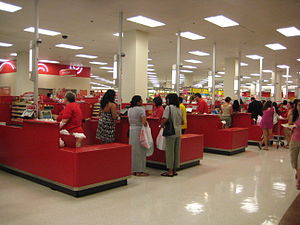
Back نقطة بيع Arabic Terminal punt de venda Catalan Pokladní místo Czech Verkaufsort German Terminal punto de venta Spanish Müügipunkt Estonian پایانه فروش Persian Point de vente French Terminal punto de venda Galician POS-terminál Hungarian

| Marketing |
|---|
The point of sale (POS) or point of purchase (POP) is the time and place at which a retail transaction is completed. At the point of sale, the merchant calculates the amount owed by the customer, indicates that amount, may prepare an invoice for the customer (which may be a cash register printout), and indicates the options for the customer to make payment. It is also the point at which a customer makes a payment to the merchant in exchange for goods or after provision of a service. After receiving payment, the merchant may issue a receipt, as proof of transaction, which is usually printed but can also be dispensed with or sent electronically.[1][2][3]
To calculate the amount owed by a customer, the merchant may use various devices such as weighing scales, barcode scanners, and cash registers (or the more advanced "POS cash registers", which are sometimes also called "POS systems"[4][5]). To make a payment, payment terminals, touch screens, and other hardware and software options are available.
The point of sale is often referred to as the point of service because it is not just a point of sale but also a point of return or customer order. POS terminal software may also include features for additional functionality, such as inventory management, CRM, financials, or warehousing.
Businesses are increasingly adopting POS systems, and one of the most obvious and compelling reasons is that a POS system eliminates the need for price tags. Selling prices are linked to the product code of an item when adding stock, so the cashier merely scans this code to process a sale. If there is a price change, this can also be easily done through the inventory window. Other advantages include the ability to implement various types of discounts, a loyalty scheme for customers, and more efficient stock control. These features are typical of almost all modern ePOS systems.
- ^ "Paperless Receipt Solution (PRS) System". James Dyson Foundation. Archived from the original on July 1, 2017. Retrieved August 9, 2015.
- ^ "Electronic Transmission of Prescriptions". Business Services Authority. Archived from the original on July 6, 2017. Retrieved August 9, 2015.
- ^ "Tricks traders use to evade billions of francs in taxes". The New Times. 9 October 2014. Archived from the original on 2017-06-30. Retrieved August 9, 2015.
- ^ "Cash register vs. POS system –what's the difference?". 30 June 2019. Archived from the original on 2023-03-30. Retrieved 2023-06-25.
- ^ "How to Choose a POS Cash Register". Archived from the original on 2023-04-07. Retrieved 2023-06-25.